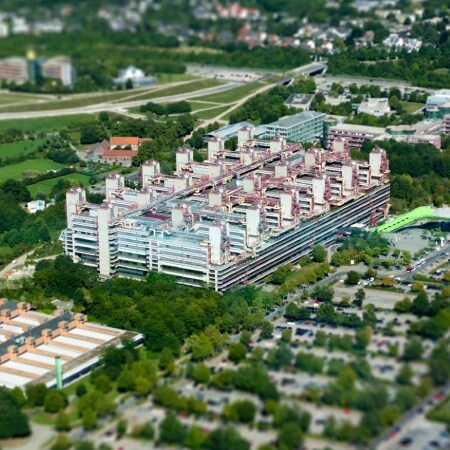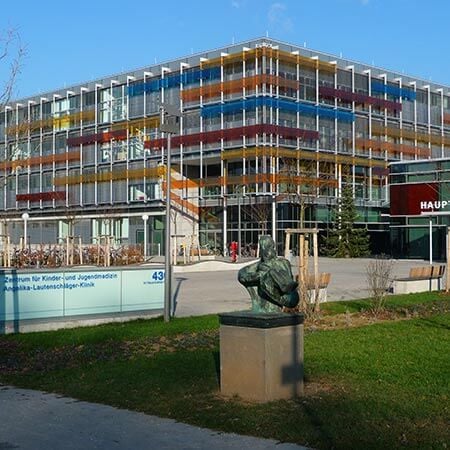Pulmonary valve insufficiency is expressed in the inability of the flaps i.e. the valves themselves to fully close, which is accompanied by the backward movement of blood from the pulmonary trunk during relaxation of the right ventricle. Pulmonary valve insufficiency causes weakness, palpitations, attacks of dyspnea, and skin cyanosis. The diagnostic scheme for pulmonary valve insufficiency includes ECG, EchoCG, jugular phlebography, chest radiography, cardiac catheterization, angiopulmonography.
Content
- Pulmonary valve anatomy
- What happens during pulmonary valve insufficiency?
- Types of pulmonary valve insufficiency
- Causes of pulmonary valve insufficiency
- Symptoms of pulmonary valve insufficiency
- How is pulmonary valve insufficiency treated in hospitals in Germany?
- Complications of pulmonary valve insufficiency
- The cost of treatment in hospitals in Germany
- Why undergo treatment in Germany with Booking Health?
Pulmonary valve anatomy
This valve connects the RV to the vessel that leads to the lung. At the phase of heart contraction (systole), blood flows unimpeded. In the resting phase, the flaps completely close the outlet opening under the influence of high pressure. It regulates the flow of low oxygenated blood.
Diseases of this heart valve are very rare. Those who are diagnosed are often caused by narrowing (pulmonary valve stenosis), leakage (pulmonary valve insufficiency), or inflammation (endocarditis) of the valve. For such cardiovascular conditions, valve replacement with prosthetics is often required.
What happens during pulmonary valve insufficiency?
The main sign of pulmonary valve insufficiency is an early diastolic descending murmur. The murmur is usually low-frequency, which distinguishes it from aortic valve insufficiency and is caused by lower diastolic pressure in the pulmonary artery compared to the aorta.
Pulmonary valve insufficiency is usually well tolerated by patients because of the low diastolic pressure in the pulmonary artery and the shape of the right ventricle. Therefore, the overall condition of patients with this defect does not suffer significantly, and exercise tolerance remains almost normal. In the absence of pulmonary hypertension and right ventricular pathology, heart failure rarely develops.
When right ventricular volume doubles, a quiet systolic murmur of blood flow through the pulmonary aortic valve appears, accompanied by a wide, but not fixed II tone dynamic. Due to increased systolic blood flow in the pulmonary trunk and pulmonary arteries, the pulse pressure in them increases and they begin to pulsate. This can be seen on EchoCG and angiography. On chest X-ray, the pulmonary trunk and pulmonary arteries are dilated. The volume of the left ventricle increases, resulting in a dilated cardiac shadow on the chest X-ray.
Types of pulmonary valve insufficiency
Congenital and acquired pulmonary valve insufficiency are distinguished depending on the time of occurrence of the cardiovascular disease.
Congenital pulmonary artery valve insufficiency occurs as a result of exposure of the pregnant body to adverse factors (for example, radiation or X-ray exposure, infection, etc.) or is inherited from one of the parents.
According to the course of congenital pulmonary valve insufficiency, the following types of cardiac condition are distinguished:
- Acute pulmonary valve insufficiency: signs of heart defect appear during the first months and years of life, mainly due to the presence of simultaneous lesions of other valves and septa of the heart.
- Chronic pulmonary valve insufficiency: signs of heart defect appear years after birth.
Depending on the cause of heart disease development, there is organic and functional pulmonary valve insufficiency.
In organic pulmonary valve insufficiency, backflow of blood from the pulmonary artery is associated with direct damage to the valve itself, which does not fully close during ventricular relaxation. In patients with functional or relative pulmonary artery valve insufficiency, backflow of blood from the pulmonary artery occurs with an undamaged pulmonary valve and is associated with pulmonary artery dilation or right ventricular dilatation.
Causes of pulmonary valve insufficiency
The most common cause of pulmonary valve insufficiency is the surgical treatment of pulmonary stenosis, either isolated or combined with an interventricular septal defect (most commonly, tetralogy of Fallot). Pulmonary valve insufficiency after valvulotomy or balloon valvuloplasty for valve stenosis is usually minimal. However, during excision of the fibrous and muscular tissue of the right ventricular outflow tract and sewing a patch to the edges of the incision with involvement of the pulmonary valve, as well as after right ventriculotomy during open correction of other heart defects, heart failure, fatigue, cardiomegaly may develop, and ECG shows a complete right bundle branch block. In this case, decompensation is probably due to a combination of valve insufficiency and right ventricular dysfunction. On its own, pulmonary valve insufficiency would not lead to heart failure, but the damaged right ventricle cannot cope with the volume overload, resulting in right ventricular failure.
Congenital pulmonary valve insufficiency is rare. It occurs as a result of different factors (for example, radiation or X-ray exposure, infection, etc.), or is inherited from one of the parents with a cardiovascular condition. The variants of congenital insufficiency of the pulmonary artery valve include:
- Congenital defect: absence or reduction in the size of one, two, or all three leaflets of the pulmonary artery valve.
- Dilation of the pulmonary artery in Marfan syndrome (a hereditary connective tissue disease with lesions of various organs).
- Idiopathic (due to unknown causes) dilation of the pulmonary artery trunk.
- Myxomatous valve degeneration (increased thickness and decreased density of the valve leaflets) occurs as part of connective tissue dysplasia syndrome (a congenital disorder of protein synthesis, in which there are disorders in the formation of collagen and elastin – proteins that form the framework of internal organs).
Acquired (related to changes in the valve leaflets) pulmonary valve insufficiency can occur due to the following causes:
- Rheumatism (involvement of various organs and body systems in inflammatory disease with predominant involvement of the heart).
- Infectious endocarditis (inflammatory disease of the inner lining of the heart).
- Syphilis (a chronic systemic venereal infectious disease with lesions of the skin, mucous membranes, internal organs, bones, nervous system, caused by a special bacterium called treponema). After 5 or more years from the onset of syphilis in the internal organs appear special nodules containing pale treponema and surrounding thickened tissue. These nodules also appear in the pulmonary artery, damaging its wall and valve.
- Carcinoid disease or carcinoid syndrome (damage to various organs due to the presence of carcinoid in the body). Carcinoid is a small tumor, most often located in the small or large intestine. The tumor produces active substances that are carried by the bloodstream to the right side of the heart, damaging the endocardium (the inner lining of the heart). Leaving the right ventricle with the bloodstream, these substances enter the vessels of the lungs, where they are destroyed and do not reach the left side of the heart. In carcinoid disease, the pulmonary artery valve may be permanently fixed in a semi-open position.
Symptoms of pulmonary valve insufficiency
Symptomatology is based on the type of malformation, the degree of valve damage, and the age of patients. Severe cardiac and respiratory failure threatens the lives of young patients in the first days after birth and requires intensive treatment. Isolated stenosis and complex malformations with narrowing of the outlet are identified as cyanotic (or "blue") malformations, due to the characteristic skin color. Cyanosis is caused by a lack of oxygen in the organs and tissues.
Symptoms are predominantly due to the underlying disease. However, with the absence of pulmonary hypertension, symptoms in patients with pulmonary artery valve insufficiency are usually absent.
Blood stasis in all organs develops with the appearance of hypertension due to overload and expansion of the right ventricle.
Manifestations of the pathology include:
- Accelerated heartbeat occurring as a protective reaction to reduce the interval between ventricular contractions.
- General weakness and impaired performance due to impaired blood distribution.
- Dyspnea (rapid breathing) developing due to disturbance of oxygen enrichment, as well as due to compression of trachea and bronchi (airways) by dilated pulmonary arteries.
- Cyanosis appearing due to impaired blood enrichment with oxygen.
With a decrease in the contractile power of the right ventricle, blood stasis develops in the systemic circulation (i.e. in all organs except the lungs) with the appearance of:
- Swelling of the legs.
- Enlargement of the abdomen due to the appearance of free fluid in it.
- Heaviness in the upper abdomen on the right side due to an enlarged liver.
Patients usually feel better in the supine position, and their condition worsens if they turn on their back.
How is pulmonary valve insufficiency treated in hospitals in Germany?
Treatment tactics for pulmonary valve insufficiency involve elimination of the underlying disease – the cause of pulmonary artery valve insufficiency.
Conservative treatment (that is, without surgery) is used to slow down the damage to the right ventricle. Drugs from the following groups are used:
- Angiotensin-converting enzyme (ACE) inhibitors – drugs that normalize blood pressure, dilate blood vessels, improve the functioning of the heart, blood vessels, and kidneys.
- Angiotensin 2 receptor antagonists – a group of drugs similar in the mechanism of action to angiotensin-converting enzyme inhibitors, used when patients are intolerant to angiotensin-converting enzyme inhibitors.
- Nitrates (salts of nitric acid) dilate blood vessels, reducing the pressure in the pulmonary arteries.
- Diuretics remove excess fluid from the body.
Special treatment for patients with pulmonary valve insufficiency is indicated when complications of pulmonary artery valve insufficiency (for example, treatment of heart failure, heart rhythm disturbances, etc.) are present.
Surgery is carried out in cases of pronounced or severe pulmonary artery valve insufficiency with significant disturbance of normal blood flow. There are different types of surgery that can be conducted for the treatment of pulmonary valve insufficiency.
For example, repair surgery (i.e. normalization of blood flow through the pulmonary artery with preservation of its valve) involves suturing of the dilated trunk (initial part) of the pulmonary artery.
Removal of the pulmonary artery valve by the means of prosthetics is performed in case of severe changes of its leaflets or subclavian structures, as well as in case of ineffectiveness of previously performed valve repair surgery. In this surgery, biological (used in children and in women who plan pregnancy) and mechanical prostheses (used in all other cases) are applied.
Heart transplant is performed in cases of significant damage to the structure of the heart with a pronounced reduction in its contractility, high pulmonary hypertension (increased pressure in the pulmonary vessels), and the availability of donor organs.
Simultaneous surgical correction of several defects, such as suturing interventricular septal defect and pulmonary artery trunk narrowing, is performed since pulmonary valve insufficiency is mainly found in combination with other heart defects.
After implantation of a prosthesis, it is necessary to take medicines of anticoagulant group (drugs that decrease blood coagulability by blocking the synthesis of substances necessary for coagulation) on a permanent basis. After implantation of biological prosthesis therapy with anticoagulants is short-term (1-3 months). No anticoagulant therapy is given after valvuloplasty.
Complications of pulmonary valve insufficiency
Complications of pulmonary artery valve insufficiency include:
- Decreased right ventricular contractility with development of tricuspid valve failure (the tricuspid valve between the left atrium and left ventricle); occurs with prolonged pulmonary valve failure.
- Pulmonary thromboembolism may occur when the thrombus breaks away from the pulmonary valve leaflet.
- Secondary infective endocarditis (inflammation of the inner lining of the heart with damage to its valves in patients with existing heart defects).
- Cardiac rhythm disturbances occurring due to changes in the normal movement of the electrical impulse in the heart.
Patients operated on for pulmonary valve insufficiency may develop specific complications after surgery, including:
- Pulmonary artery thromboembolism. Thrombus in such patients is formed in the area of surgery (for example, on the artificial valve leaflets or the sutures of valve repair surgery).
- Infectious endocarditis (inflammation of the inner lining of the heart).
- Paravalvular fistulas (rupture of part of the sutures that hold the artificial heart valve with the appearance of blood flow behind the valve).
- Prosthesis thrombosis (formation of blood clots in the area of the valve prosthesis, disturbing the normal blood flow).
- Destruction of biological (made of animal vessels) prosthesis with the need for repeated surgery.
- Calcinosis of biological prosthesis (deposition of calcium salts in a biological artificial heart valve) leads to thickening of the valve and deterioration of its mobility.
The prognosis of pulmonary artery valve insufficiency depends on the severity of the underlying disease that initiated the heart defect, as well as the severity of the valve defect, myocardial condition, and the presence of other heart defects. In general, the prognosis is determined by disorders of intra- and extracardiac hemodynamics (blood flow).
In pulmonary artery valve insufficiency, appearing from the first days of life, mortality is extremely high, even with timely surgical treatment. In isolated pulmonary valve insufficiency (that is, in the absence of other heart defects) or in combination with moderate pulmonary artery stenosis, patients live many years without discomfort.
The cost of treatment in hospitals in Germany
The latest diagnostic methods and cardiac surgery techniques underpinning the work of physicians in hospitals in Germany, as well as all kinds of wellness and risk factor interventions, provide excellent results and live up to the expectations of patients coming for treatment in Germany. Physicians and nursing staff are greatly assisted by psychologists and social workers because a patient with a cardiovascular condition needs all kinds of medical help and rehabilitation.
The cost of treatment in hospitals in Germany and diagnostic procedures is calculated on an individual basis. By requesting diagnosis and/or treatment in Germany, you will receive an individual detailed plan and preliminary price for treatment in German hospitals (recalculation of the cost is possible in the process of treatment/medical examination).
The prices for diagnostics of pulmonary valve insufficiency start at 463 EUR.
The cost of treatment in Germany with valvuloplasty starts at 5,333 EUR.
The cost of treatment in Germany with replacement surgery starts at 9,964 EUR.
The cost of treatment in Germany with surgery for valve repair starts at 9,785 EUR.
Why undergo treatment in Germany with Booking Health?
Booking Health undertakes selection of the hospital, preparation of documents, help with medical visa and air tickets, arranges transportation and provides interpreters, solves the problem of accommodation, and communication with the chosen medical facility. Booking Health also provides short initial consultation regarding treatment options, help with medical visa application, ticket purchase, hotel booking, and overall organizational issues.
If you want to use the stress-free option of treatment arrangement, leave your request on the Booking Health website for us to contact you.
Authors: Dr. Vadim Zhiliuk, Dr. Sergey Pashchenko




















